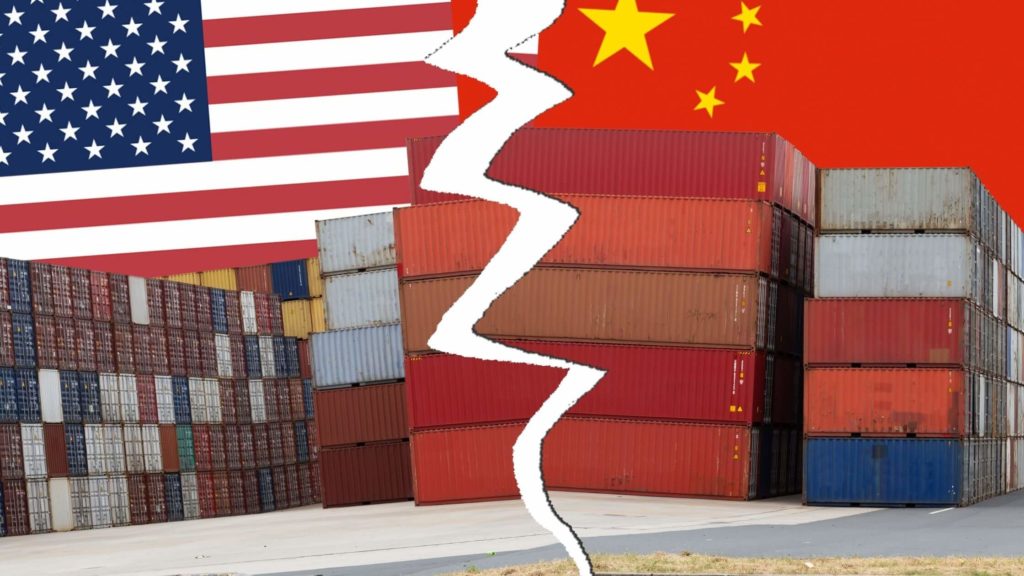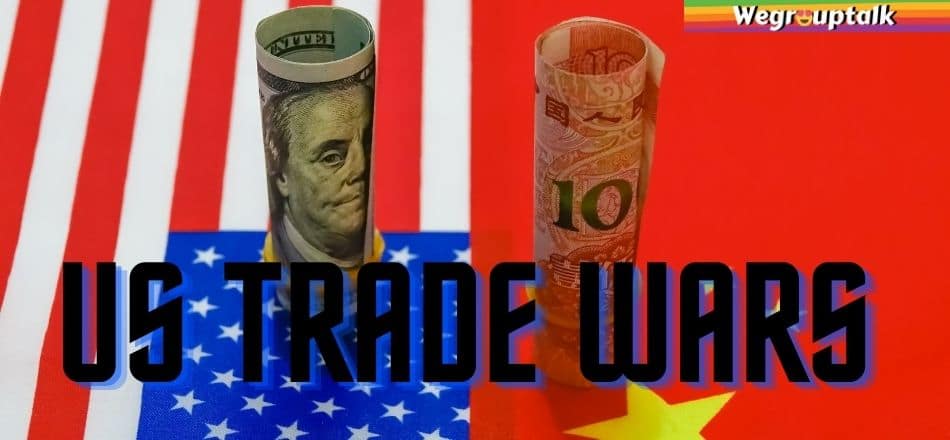We have all heard about nuclear wars as seen in World war II or, more recently happening a biological warfare, the one of Covid-19. But have you ever heard of a trade war and how large an impact they can have? Somehow, the fact that remains constant is that neither the governments nor its leaders are whichever war it is. Still, it is the country’s common man who suffers the most. So, this blog post is about the trade war, particularly in the United States.
What is a trade war?
A trade war is when a country or nation imposes tariffs or quotas on imports. A similar type of trade protectionism (a policy that protects domestic industries from unfair foreign competition can be a politically motivated defensive measure) and foreign countries retaliate. A trade war limits foreign trade as it escalates. When a nation tries to defend its domestic industries and create employment, a trade war begins. It will function in the short run. Tariffs are expected to give the domestic manufacturers of that commodity a competitive advantage. Their rates will, by contrast, be lower.
As a consequence, they will get more orders from local consumers. As their companies expand, they will add employment. But a trade war does cost jobs in the long run. For all countries concerned, it depresses economic development. It also reduces inflation as tariffs raise import prices.
An elucidation for better understanding
The dust bowl (It was a natural phenomenon that, in the 1930s, destroyed the midwest. In a thousand years, it was the worst drought in North America. One unhealthy agricultural practice exacerbated the impact of the drought, destroying the crops that held the soil in place.) This had raised the food prices for America’s citizens that were already suffering from the Great Depression ( The Great Depression was a worldwide financial crisis that lasted for ten years. It started on Black Thursday, 24 October 1929.
In the 1929 stock market crash, stock prices plunged 22% over the next four days. The crash cost investors $ 30 billion, today’s equivalent of $ 396 billion. That scared the public because the crash cost more than World War I.) Other countries retaliated to this with their tariffs. The trade war had decreased foreign trade by 65%. It turned a contraction into a depression and lead to the beginning of the second world war.
Trump’s trade wars
To eliminate the U.S. trade deficit, President Donald Trump launched a trade war. Since 1975, it’s been the world’s largest. Deficit reduction has been a part of Trump’s plan to generate more jobs. Part of the U.S. deficit derives from American enthusiasm for consumer goods and vehicles that are imported. The deficit was $577 billion in 2019. $3.1 trillion in products and services were imported by the U.S., while $2.5 trillion was exported.
The U.S. intake of imported consumer goods is responsible for much of the deficit. These include pharmaceuticals, T.V.s, apparel, and other household goods. The import of vehicles and parts are another major contributor.
Trump, in early 2018 said, “Trade wars are good and easy to win.” After this, he initiated three of them: a global steel tariff, the European car tariff, and Chinese import tariffs. After this announcement by Trump, a fear of a trade war between the world’s three largest economies, global financial markets tumbled.
In late 2018, “tariffs hurt the heartland” was founded by many U.S. businesses. The growing cost of imported materials hurts them. In 2020, the Congressional budget office predicted the cost to the average American household of trade barriers to be $580.9, which includes higher costs and lost economic growth.
Farmers have been suffering from retaliatory tariffs levied on their exports by China and Europe. In 2019 farm bankruptcy filings in nine states hit or surpassed record highs, a rise of 24% over the previous year. On 23 May 2019, Trump gave $16 billion in assistance to farmers to partly compensate for the losses. In 2018, he gave them $12 billion. Other countries are establishing trade deals that exclude the United States. The E.U. upgraded its agreement with Mexico in April 2018, removing all tariffs. E.U. signed an agreement with Japan in July 2018 that lowers or ends tariffs on almost all products.
Tariffs on steel
A 10% tariff on aluminium and a 25% tariff on steel imports were declared by the Trump administration on 8 March 2018. The reliance on imported metals undermines America’s ability to manufacture steel and aluminium for national security. Trump’s tariffs, the Aerospace Industries Association said, will instead increase the cost of the military. The only body authorised to impose tariffs is the U.S. Congress. But in 1962, the President was allowed to limit imports that threatened national security. It is unlikely for the World Trade Organization to settle trade conflicts concerning defence.
Thanks to consumers, including automakers, America is the world’s largest steel importer. Compared with about 140,000 employees in the U.S. steel industry, steel importers employ 6.5 million workers. For the big three automakers, tariffs limited second-quarter profits. They passed those costs on to customers to please shareholders. Tariff costs have far outweighed the advantages of Trump’s tax reform. Complaints were lodged with the World Trade Organization by the European Union, Canada, India, Mexico, Norway, Switzerland, China, Turkey, and Russia.

Trump exempted Canada, Mexico, South Korea, Argentina, Australia, Brazil, and the European Union from the steel and aluminum tariff on 22 March 2018. South Korea agreed to double its import quota for U.S. automobiles. It authorized the United States until 2041 to retain its 25 percent tariff on pickup trucks.
Canadian Prime Minister Justin Trudeau said that Canada would retaliate with tariffs after the G7 meeting on 9 June 2018. Mexico announced tariffs that included steel, aluminum, pork, and other products. Trump decided on 17 May 2019 to lift the tariffs on steel imports from Canada and Mexico in 48 hours.
Tariffs against Mexico
On 30 May 2019, effective 10 June, Trump threatened to place a 5% tariff on all imports from Mexico. He wants the government to decrease the number of asylum seekers present in the United States and Mexico border. If required, he vowed to increase the tariff to 25% to compel Mexico to act.
The tariff will be a NAFTA ( North American Free Trade Agreement; signed in 1994 by the United States, Mexico, and Canada governments to encourage free trade between these three countries) breach. By declaring a national emergency, Trump said he might override the trade deal. Republicans, who’ve always backed the President, then threatened to condemn the action.
Major timeline of the events of the U.S. – China trade war
The largest U.S. trade deficit by the nation is with China, by far. The U.S. trade deficit with China in 2018 was 419 billion dollars. $540 billion, mostly in machines, mobile phones, and clothing, was imported by the United States. Most of it is made by U.S. companies in China, but imports are still considered. U.S. businesses have exported 120 billion dollars to China. Commercial aircraft, equipment, optical and medical devices, and automobiles were mainly involved.
Trump aimed to restrict U.S. technology transfers to Chinese businesses in addition to lowering the trade deficit. China needs foreign companies to disclose their trade secrets if they wish to sell goods in China. In its “Made in China 2025” strategy, the administration has also requested China to avoid subsidizing the ten industries prioritized.
These include robots, software, and aerospace. China also plans to be the main hub of artificial intelligence in the world by 2030. And, China will be most likely to disagree with the demands of Trump.
The Trump administration imposed three tariffs on a total of $250 billion in Chinese imports. 30 These tariffs were estimated by the Federal Reserve to cost the average household $414 per year. Trump levied a fourth tariff on 10 May 2019. He raised tariffs to 25% on goods worth $200 billion. 32 The Federal Reserve estimated that this tariff would cost the average household $831 a year combined with the previous 2018 tariffs.
Trump, after that, increased the pressure on the ongoing trade talks. He threatened to increase the tariff to an additional Chinese import tariff of $325 billion. This raised rates for virtually all Chinese imports. Trump postponed the planned tariffs to facilitate renewed trade talks with China on 29 June 2019. China responded with a 25% tariff on $60 billion of U.S. goods on 1 June 2019. 30 Some investors are also worried that China may sell some of its U.S. debt of $1.1 trillion.
Donald Trump threatened a 10% tariff on Chinese electronics and clothing on 13 August 2019. That would send higher interest rates and slow the U.S. economy. The tariff started to mitigate damage to the holiday shopping season on 15 December.
Trade war with the European Union
The E.U. threatened to take measures against the U.S. on 7 March 2018 to comply with tariffs’ economic losses. To this, Trump delayed the steel tariff until 1 May 2018. The E.U. upgraded its trade deal with Mexico on 21 April 2018. This eliminates tariffs from virtually all trade between the two regions.
On 30 April 2018, Trump announced he would delay the steel tariff against the E.U. until 1 June, 2018.75 He wanted the U.S. ally to cut its 10% tariff on U.S. autos. He also asked the E.U. to set quotas on its steel exports. But on 31 May 2018, Trump rescinded the delay. He imposed the tariff on Mexico, Canada, and the E.U. The U.S. Aluminum Association said that the move would threaten “supply chains that rely on more than 97% of U.S. aluminum industry jobs.”
On 21 June, Germany proposed to end the E.U.’s 10% tax on United States auto imports if Trump forgot about imposing a 25% tax on European auto imports. There is already a 25% U.S. tariff on light trucks. On 22 June, the E.U. retaliated against steel tariffs with tariffs on US$3.2 billion in goods. It targeted imports which would influence the political base of Trump. Bourbon, cars, and orange juice are examples of these taxable imports.

The E.U. concluded a Trade Agreement with Japan on 17 July 2018. It lowers or ends tariffs on almost all products. It created the largest free trade zone on the globe, covering approximately $152 billion in goods. On 1 February 2019, it entered into force. The E.U. and the United States decided on 25 July 2018 to hold off any new tariffs, reassess the tariffs on steel and aluminum, and work towards zero tariffs on non-auto industrial products.
The E.U. agreed to import more U.S. liquefied natural gas and soybeans. This will minimize its dependency on Russian LNG and benefit American farmers who have lost the Chinese market due to the trade war. But the price of Russia’s LNG is much lower than that of America, so it is doubtful that any significant improvements will be made there.
Trump declared on 9 April 2019 that he will impose tariffs on $11 billion in European imports. He wants to push the E.U. to end subsidies to the manufacturer of aircraft, Airbus. The tariffs could increase the prices of cheese, bicycles, and kitchen knives being imported.
How it affects you?
The trade war has boosted the price of consumer products that use steel and aluminium. Costs for manufactured garment hangers, heavy machinery components, and computer chip and tool manufacturers have risen. The Car Manufacturers Alliance cautioned that if cheap imports are eliminated, U.S.-produced steel would cost more. The tariffs hiked vehicle prices for all customers, limit consumer choice, and encourage our trading partners to take retaliatory action. They are made more costly by international tariffs on U.S. exports.
To stay competitively priced, U.S. exporters will have to slash expenses and lay off staff. They could further cut costs or even go out of business if they struggle. Trade wars hinder economic development in the long run. When foreign countries retaliate, they cause more layoffs, not less—laid off may be the 12 million U.S. workers who owe their employment to exports.
Oxford Economics forecast that the trade war will cost the global economy $800 billion in decreased trade. That could delay growth by 0.4%. Trade wars weaken the secured domestic industry over time. Companies within the industry don’t need to innovate without international rivalry. The local product will gradually decline in output compared to foreign-made products.
So, this was all about the trade war that has been going on lately. I hope it helped you in making more aware of what is happening in the business world. All this can have a very significant impact on the future of globalization of this world. Although tactics like these are not new and have been prevalent for long, they have become prominent. They have started gaining the attention of the common people. This is why knowing all this has become so important for us.
Also, Read- Causes behind the economic dropdown in India
Follow us on FACEBOOK, INSTAGRAM and TWITTER to stay connected.




